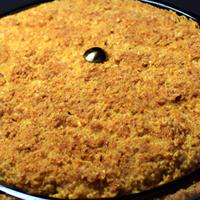
1 serving (28 grams) contains 100 calories, 3.0 grams of protein, 1.0 grams of fat, and 20.0 grams of carbohydrates.

Log this food in SnapCalorie

Nutrition Information
Calories |
400 | ||
|---|---|---|---|
% Daily Value* |
|||
| Total Fat | 4 g | 5% | |
| Saturated Fat | 0 g | 0% | |
| Polyunsaturated Fat | 0 g | ||
| Cholesterol | 0 mg | 0% | |
| Sodium | 800 mg | 34% | |
| Total Carbohydrates | 80 g | 29% | |
| Dietary Fiber | 4 g | 14% | |
| Sugars | 4 g | ||
| protein | 12 g | 24% | |
| Vitamin D | 0 mcg | 0% | |
| Calcium | 40 mg | 3% | |
| Iron | 2 mg | 11% | |
| Potassium | 120 mg | 2% | |
* Percent Daily Values are based on a 2,000 calorie diet. Your daily values may be higher or lower depending on your calorie needs.
Food Attributes
Source of Calories
About Panko crust
Panko crust is a type of breadcrumb originating from Japan, widely used in Asian cuisine for its light, crispy texture. Rather than traditional breadcrumbs, panko is made from crustless white bread that is processed into large, airy flakes and dried. It’s commonly used to coat foods for frying or baking, providing a crunchier and less dense alternative. Panko breadcrumbs are low in calories and fat, making them a healthier option compared to heavy batters or traditional breading. They are typically free of additives or spices, allowing for versatility in recipes. However, their nutritional profile lacks significant vitamins, minerals, and fiber, so they’re not a substantial source of nutrients. For those mindful of sodium intake, it’s worth checking packaging labels, as some brands may add salt. Overall, panko crust offers a lighter way to achieve a satisfying crunch in various dishes.



